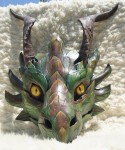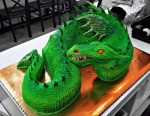 Another lovely dragon cake, this time via theCHIVE. Original source unknown; please comment if you know who made this or took the picture.
Another lovely dragon cake, this time via theCHIVE. Original source unknown; please comment if you know who made this or took the picture.
Author: dhenke
Email: dhenke@mythopoeic.org
Ice Dragon
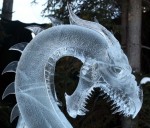 This ice dragon is from a work entitled “Hunting Dragons”, by Steve Brice, Heather Brice, Steve Cox and Justin Cox. (I presume and hope that the title refers to the dragons in question hunting their prey.)
This ice dragon is from a work entitled “Hunting Dragons”, by Steve Brice, Heather Brice, Steve Cox and Justin Cox. (I presume and hope that the title refers to the dragons in question hunting their prey.)
The sculpture won first place in the Realistic / Artists’ Choice category in the 2013 World Ice Art Championship in Fairbanks, Alaska. The photo is via The Chive, and is unfortunately uncredited. (If you have information about the photographer, please let me know and I’ll add appropriate attribution.)
Another image available after the break.
Stumped
 Excellent dragon carved from (or at least sitting on) a tree stump. Via Reddit. I have no information about the location or artist; please email or comment if you do. (As usual, click the image for a larger version.)
Excellent dragon carved from (or at least sitting on) a tree stump. Via Reddit. I have no information about the location or artist; please email or comment if you do. (As usual, click the image for a larger version.)
Spring Dragon
Dragonlords of Werner, Werner & Fulk
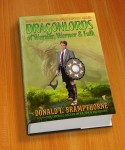 Dragonlords of Werner, Werner & Fulk. Winner of the 2003 Business Fantasy Award. An intense, gripping tale of swordplay, magic, romance and intermarket sector spread. You won’t be able to put this one down, unless it’s for the latest issue of CEOWORLD Magazine.
Dragonlords of Werner, Werner & Fulk. Winner of the 2003 Business Fantasy Award. An intense, gripping tale of swordplay, magic, romance and intermarket sector spread. You won’t be able to put this one down, unless it’s for the latest issue of CEOWORLD Magazine.
(From Sean Tejaratchi’s LiarTownUSA. Click image to right to enlarge.)
Pogoplug SAN using AoE
 The Pogoplug E02 is a Linux-capable embedded computer with gigabit Ethernet and USB connectivity. It can be found quite cheap (US$35 or so) on the secondary market. As it was originally sold as a storage appliance for home users, it ships with somewhat inflexible factory firmware. However, it is reasonably easy to replace the bootloader with one which can boot an arbitrary Linux distribution.
The Pogoplug E02 is a Linux-capable embedded computer with gigabit Ethernet and USB connectivity. It can be found quite cheap (US$35 or so) on the secondary market. As it was originally sold as a storage appliance for home users, it ships with somewhat inflexible factory firmware. However, it is reasonably easy to replace the bootloader with one which can boot an arbitrary Linux distribution.
Once I got my Pogoplug running Debian, it was surprisingly easy to set it up as network storage using ATA-over-Ethernet. Details after the jump.
Raspberry Pi, GPS and NTP
The Raspberry Pi is an inexpensive ARM7-based single-board computer that runs Linux. Using it, together with an almost-equally-inexpensive GPS receiver module from Adafruit Industries, I was able to set up a reasonably good NTP server for my home network. While the hardware side was almost ridiculously easy, the software required a bit of effort, including building a custom kernel and building ntpd from sources. Full details after the jump.
Ubuntu 12.04.1 LTS: Recovering from a Broken libc
Note: Reasonably heavy UNIX-geekery ahead. Mostly Linux-specific, somewhat Debian-specific and a little bit Ubuntu-specific. Skip if that isn’t your cup of ichor.
I recently did something incredibly ill-considered while logged in (as root, natch) to my Ubuntu server box at home. In essence, I told the package manager to uninstall libc.
On a scale from good to bad, this is bad.
Now, I could have booted up from a rescue disk and fixed it. I could have re-installed easily enough (using the trick where you just keep your existing partitions and don’t format them — though this would have inevitably led to some fallout as various config files and customizations got clobbered). Heck, I even had a reasonably recent backup at hand. None of these sounded especially fun, mostly because the machine was in a place where it’s a hassle to stick a head on it. I had three things working in my favor: an open root-privileged shell prompt, Internet connectivity and my native cunning.
Read on after the jump for the full tale.
Karotz: Movies Application
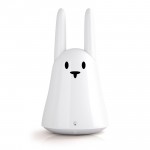 The Karotz (née Nabaztag) is an Internet-connected embedded system in the form of a stylized mechanical rabbit. I received one of these as a gift, and it’s actually kind of cool. It lacks any kind of display (other than a single multi-color LED), but does have such amenities as a camera, microphone, RFID reader, motorized ears, robust text-to-speech and a Javascript API.
The Karotz (née Nabaztag) is an Internet-connected embedded system in the form of a stylized mechanical rabbit. I received one of these as a gift, and it’s actually kind of cool. It lacks any kind of display (other than a single multi-color LED), but does have such amenities as a camera, microphone, RFID reader, motorized ears, robust text-to-speech and a Javascript API.
My first application for the Karotz is called Movies. It scrapes the Google movie listings, and reads you upcoming titles and showtimes for the theater of your choice. Full source download and additional discussion after the break.
CD Dragon
 A fine dragon sculpture, made by an anonymous Imgur user. Medium: CD shards, hot glue and wire mesh. More images after the jump. Via Obvious Winner.
A fine dragon sculpture, made by an anonymous Imgur user. Medium: CD shards, hot glue and wire mesh. More images after the jump. Via Obvious Winner.
